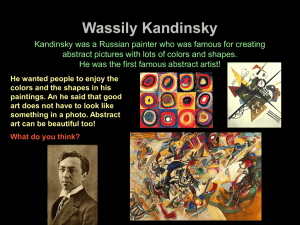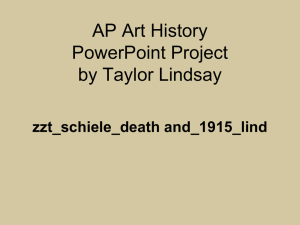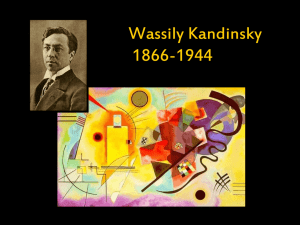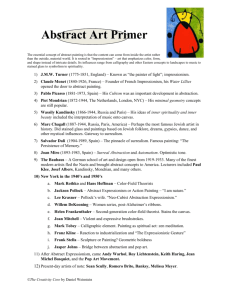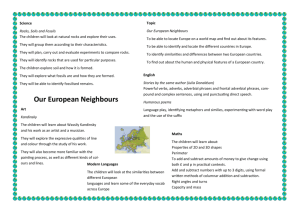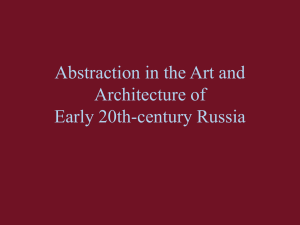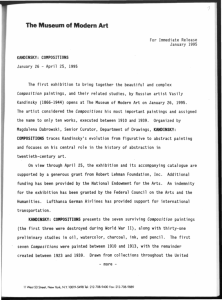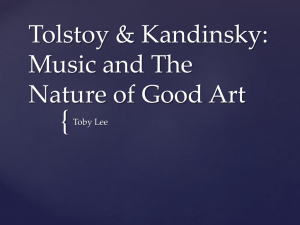Kandinsky
advertisement
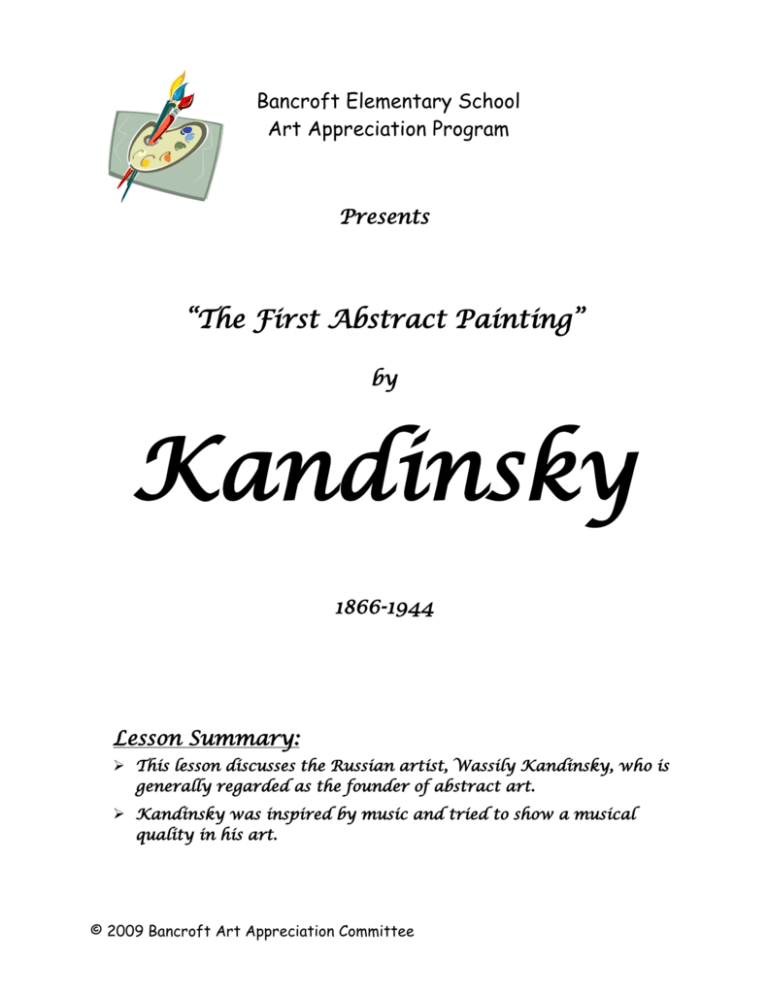
Bancroft Elementary School Art Appreciation Program Presents “The First Abstract Painting” by Kandinsky 1866-1944 Lesson Summary: This lesson discusses the Russian artist, Wassily Kandinsky, who is generally regarded as the founder of abstract art. Kandinsky was inspired by music and tried to show a musical quality in his art. © 2009 Bancroft Art Appreciation Committee VOLUNTEER CHECKLIST Lesson Information Artist: Wassily Kandinsky (1866-1944) Art Title: “The First Abstract Painting” Period or Style: German Expressionism and Abstract Art Element: Movement Project/Medium: Watercolor abstract paintings with black oil pastel resist drawings Prep-work Required Discussion: Familiarize yourself with current lesson details Art Activity: Decide on music you wish to play to inspire the kids. -The initial “drawing” song may be more up-tempo than the rest of the music that you play to paint to. Presentation Materials Electronic Images: “The Scream”, ”The First Abstract Painting” ‘Lyric’ (Man on a Horse); ‘Indian Story’; ‘Ladies in Crinolines’; ’Group in Crinolines’; ‘Composition IV’; ‘Composition VII’; “Composition VIII’; ‘Blue Mountain’; ‘Improvisations 28’; ‘Painting w/ White Border’ On “thumb” drive in cabinet Music Bring music or get a player from your Ask teacher teacher Lesson Plan Kandinsky In folder Art Project Project samples In folder Activity Materials Watercolor paper 1 sheet per student Liquid Watercolor paints in trays and brushes variety per student Water cups, paper towels, newspaper to cover desk 1 each per student Black oil pastels 1 each per student © 2009 Bancroft Art Appreciation Committee KANDINSKY LESSON PLAN Lesson Objectives To introduce students to the life of Russian artist, Wassily Kandinsky. To learn about Expressionism and Abstract art. To discuss MOVEMENT in art. Presentation Timing With Upper Grade students, your discussion time may be a bit longer than with the lower grades. Spend 10-15 minutes on the lesson and the rest of the hour on the art project. Share important facts from the lesson plan. Expressionism and Abstract Art Expressionism was a movement in art in the early 20th century that used color to express strong personal emotions. This group of painters sometimes painted quiet, meditative art and other times used color to express raw anger with distorted figures and reality. (Show Munch, “The Scream”) The Expressionists were formed in Germany and were separate from the Fauves in France, another group using expressive color. Wassily Kandinsky was part of the German Expressionists but also later became the first Abstract artist. In 1910 Kandinsky began a series of paintings containing only colors and shapes and not representing anything in the real world. This is the definition of Abstract art. It all began when Kandinsky saw one of his own paintings upside down and was so struck by it’s beauty that he was inspired to paint in a different way. During the next few months, he worked furiously to remove all recognizable objects from his paintings and making them very colorful. Abstract art was born. © 2009 Bancroft Art Appreciation Committee Kandinsky Wassily (VEHSEE ly) Kandinsky (help pronounce) was born in Russia and his great-grandmother was a Mongolian princess. Growing up in Russia, Kandinsky was surrounded by music. Both of his parents were accomplished musicians, and Kandinsky himself played the piano and cello. He studied to be a lawyer and was appointed a Professor of Law at the local University, but gave up his career to devote himself to painting. He was so inspired by Monet’s ‘Haystacks’ and the music of Composer Wagner that he was wanted to become a full-time artist. He was inspired by Monet’s use of values of color and light and when he listened to Wagner, he closed his eyes and saw wild lines and the violins and wind instruments mentally created an entire gamut of colors he felt compelled to paint. He moved to Munich, Germany, which was one of the centers of European Art. He was attracted to anything intellectual and joined different art groups and schools that were on the cutting edge. He created what is considered the first abstract painting in the history of art in 1910 called aptly ‘First Abstract Painting.’(Show) He loved color and believed that “every color has a mysterious life of its own” and makes the viewer feel strong emotions. How does the color red make you feel (Angry? Hot?) How about blue (Calm? Cool?) Yellow (Happy? Warm?) Colors are symbolic and have a tendency to make the viewer “feel” emotions when they are looked upon. Kandinsky progressed from vaguely representational to simplification of forms and to separating forms geometrically. He listened to music while painting, believing that the music would influence the feel of the painting. In fact, he even named his paintings for parts of music and songs. (Show the rest of Slides) Kandinsky wanted the paint to act like notes in a piece of music. He wanted his art to channel light, vital energy, feelings and emotions, not just represent objects. Kandinsky insisted that art shouldn’t be explained by the artist but should be felt by the viewer. He believed the artist’s feelings were private. So, when someone would ask Kandinsky what his painting “was,” he said that it didn’t matter what he thought it was. The important thing is what the viewer thought and how the viewer felt looking at the painting. © 2009 Bancroft Art Appreciation Committee 4 Kandinsky taught at the famous Bauhaus school of construction and art design in Germany from 1922-1933. This was a place of free experimentation with art and design. As the National Socialist Party (Nazi’s) gained power in Germany they started a large-scale campaign against the Bauhaus and shut it down. They also labeled all the Expressionists including Kandinsky as ‘Degenerate’ and confiscated many of the 450 paintings Kandinsky made up to that time. Kandinsky fled to France where he lived out the rest of his life. Movement in Art MOVEMENT is the path our eyes follow when we look at a work of art. The purpose of movement is to create unity in the artwork with eye travel. This can be achieved by using repetition, rhythm, and action. By arranging the composition elements in a certain way, an artist controls and forces the movement of the viewer's eyes in and around the composition of the painting. For example, the eye will travel along an actual path such as solid or dotted line, or it will move from large elements to small elements, from dark elements to lighter elements, from color to non color, from unusual shapes to usual shapes, etc. Kandinsky used MOVEMENT successfully in his paintings. He was especially fond of using Rhythm. Rhythm is the result of repetition, which leads the eye from one area to another in direct, flowing, or staccato movement. A line may vary in length, weight, or direction. Color may also be repeated in various parts of the composition in order to unify the various areas of the painting. Watercolor Demonstration (Optional) Who has used watercolors? What color do you add to a basic color to usually make it lighter? White. When using watercolors, you don’t add white to lighten a color. What might you do? Add water. To get a more intense color, you use more paint and less water. Demonstrate: Dip brush into color with VERY LITTLE water then paint a swatch onto a paper taped high on the blackboard so everyone can see. Dip in more water then paint. Do you see the difference? Did the color lighten? © 2009 Bancroft Art Appreciation Committee 5 Demonstrate how to dab the paintbrush on a paper towel if there is too much liquid on it. Demonstrate how to change a color. Clean the brush in water by “scrubbing” the bristles in the bottom of the water container, and then dab on a paper towel or squeeze with fingers without pulling. Then, dip the brush into a new color. Demonstrate how to mix colors—use only two in mixing. If you use more, colors turn a yucky brown. Watercolors will “bleed” into each other (the watercolor will go where it is wet). So be careful when painting that the colors do not mix on the paper and create a muddy color. Leave a small, dry space between colors if you don’t want them to mix. Always leave some white space in your paintings…it makes it more interesting. To avoid mushy paper, don’t smash brush or rub on paper or overwork an area. To save paintbrush for other uses, don’t pull on hairs or smash paintbrush. To prevent warping, don’t use too much water. © 2009 Bancroft Art Appreciation Committee 6 Art Activity Have the tables covered with newspaper and smocks available to the students. Show sample to students for inspiration. Emphasize that each student’s art will look different and unique because their personality will show in their own piece. Hand out a piece of watercolor paper to each student. Ask them to write their own name and their teacher’s name on the back. Turn on the fast tempo music selection. Ask the students how the music makes them feel. Does it sound happy? Sad? Exciting? What does their body want to do? Move? How? In a slow, dreamy way or a bouncy, energetic way? Have the students settle down a bit and tell them to close their eyes while listening to the slow/classical music selection. Ask the same questions regarding how the music makes the student artists feel. How does the artist’s body want to move? Tell the students that NOW; while they are listening to the fast music selection, they will draw abstractly with the black oil pastel. They should let the music tell them what to do. They do not have to draw immediately. In fact, they should listen for a few seconds before beginning. Remind them that the goal is to create a piece of “art,” not just to scribble. Let the music dictate how hard to press and in which direction the crayon should go. (This part should only take a few minutes at most.) Turn off the music and have the students put away the black oil pastel. Now have them listen to the slower music selection and start the watercolor portion of the project. This will take longer and the music will run on for a while. Encourage them to experiment with different techniques-dabbing, dripping and blending. Also encourage them to add splashes of bold colors throughout their painting to add interest. Remember that Kandinsky loved bold color. Place to dry on the drying rack and return the next day to store safely until the end of the year. © 2009 Bancroft Art Appreciation Committee 7

